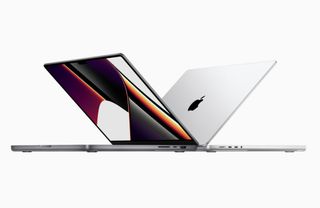Apple unveils redesigned MacBook Pro with M1 Pro, M1 Max chips
Apple's latest high-end laptops pack the company's second-generation homegrown silicon

Apple has unveiled new 14-inch and 16-inch MacBook Pro devices, which pack the latest version of the company's M1 ARM-based architecture.
The laptops represent the second round of laptops to ditch Intel in favor of Apple's homegrown M1 chip. The first, unveiled in November 2020, included a Mac Mini, MacBook Air, and a 13-inch MacBook Pro.
During its virtual October 18 event, the company announced two new chips in the M1 series that will make their debut inside the new MacBook Pro units.
The M1 Pro integrates the GPU and CPU in a single system on a chip (SoC). It increases the width of the memory interface to 200GB/sec and supports up to 32GB of unified memory. The M1 Pro chip has 10 CPU cores and 16 cores for its GPU, and also includes dedicated silicon for driving multiple displays.
Its more powerful sibling, the M1 Max, has 400GB/sec of memory bandwidth, supports up to 64GB of unified memory, and sports a 32-core GPU.
These chips equip the new laptops with support for up to 64GB of RAM and make them more energy-efficient. The 14-inch MacBook Pro supports up to 17 hours of video playback, while the 16-inch model lasts up to 21 hours. When you do run out of charge, systems feature fast-charge technology for a quick top-up.
The most visible upgrades in the new MacBooks, however, are the displays. They feature higher resolutions than previous units, at 3024x1964 for the 14-inch unit and 3456x2234 for the 16-inch model. This beats the 13-inch MacBook Pro's display resolution of 2560x1600 and the older 16-inch model's 3072x1920.
Get the ITPro. daily newsletter
Receive our latest news, industry updates, featured resources and more. Sign up today to receive our FREE report on AI cyber crime & security - newly updated for 2024.
The mini-LED displays feature the company's ProMotion technology, which adjusts the refresh rate up to 120Hz, depending on what the user is doing. Display brightness rangers up to 1,600 nits.
The bezels on the new MacBook Pros are far smaller, to the point where the company had to introduce an iPhone-style notch in the top of the display to make room for the 1080p camera and microphone.
Apple has also dropped the controversial OLED Touchbar feature, which some users called a gimmick, replacing it with physical function keys.

IT Pro 20/20: Using technology to create a better future
Issue 21 of IT Pro 20/20 looks at the newest innovations and projects shaping our interactions with the world around us
The MacBook includes an HDMI port, SD card slot, and three Thunderbolt 4 ports for connectivity. MagSafe magnetic charger technology, which it discontinued in 2016 in favor of USB-C connectors, also returns.
The 14-inch MacBook Pro starts from $1,999, and the 16-inch MacBook Pro starts at $2,499. For educational customers, the prices fall to $1,849 and $2,299, respectively.
Other announcements at the event included the company's third-generation sweat- and water-resistant AirPod earbuds. These new buds bring the AirPod Pro's AdaptiveEQ technology to the base-level devices, a longer, six-hour battery life, and MagSafe wireless charging.
Apple also announced Homepod Mini speakers in multiple colors and enhanced its music offering with a low-cost voice plan. It provides voice-only access to songs and playlists but doesn't offer its spatial lossless audio capability. It also includes Apple-authored playlists for various events.
Danny Bradbury has been a print journalist specialising in technology since 1989 and a freelance writer since 1994. He has written for national publications on both sides of the Atlantic and has won awards for his investigative cybersecurity journalism work and his arts and culture writing.
Danny writes about many different technology issues for audiences ranging from consumers through to software developers and CIOs. He also ghostwrites articles for many C-suite business executives in the technology sector and has worked as a presenter for multiple webinars and podcasts.





